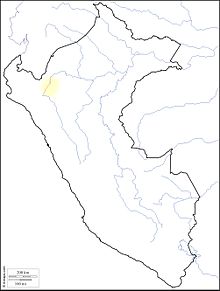The Marañón poison frog (Excidobates mysteriosus; rana venenosa Marañón in Spanish) is a species of frog of the family Dendrobatidae. It is endemic the Cordillera del Condor, in the upper Marañón River drainage, of Cajamarca Department, Perú.[2] As per the type locality, its natural habitat is primary premontane forest. Breeding takes place in rainwater-filled bromeliads (Bromeliaceae sp). It is threatened by habitat loss, and is currently listed as endangered by the IUCN. It may also be collected for the international exotic animal trade, though several vital captive breeding projects are underway in their native regions.[1]
| Marañón poison frog | |
|---|---|

| |
| Scientific classification | |
| Domain: | Eukaryota |
| Kingdom: | Animalia |
| Phylum: | Chordata |
| Class: | Amphibia |
| Order: | Anura |
| Family: | Dendrobatidae |
| Genus: | Excidobates |
| Species: | E. mysteriosus
|
| Binomial name | |
| Excidobates mysteriosus (Myers, 1982)
| |

| |
| Distribution of the Maranon Poison Frog | |
| Synonyms | |
|
Dendrobates mysteriosus Myers, 1982 | |
References edit
- ^ a b IUCN SSC Amphibian Specialist Group (2018). "Excidobates mysteriosus". IUCN Red List of Threatened Species. 2018: e.T55193A89201026. doi:10.2305/IUCN.UK.2018-2.RLTS.T55193A89201026.en. Retrieved 17 November 2021.
- ^ Frost, Darrel R. (2014). "Excidobates mysteriosus (Myers, 1982)". Amphibian Species of the World: an Online Reference. Version 6.0. American Museum of Natural History. Retrieved 30 July 2014.
